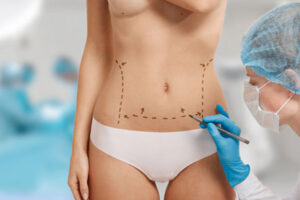Abdominoplasty, also known as ‘tummy tuck’, is an cosmetic operation in which excess fat and sagging skin tissue in the middle and lower abdomen are removed and weak abdominal muscles are stretched and strengthened. Although the appearance of fat and sagging skin in the abdominal area is most commonly due to excess weight, tummy tuck is not a treatment for obesity.
The cause of deformation in the abdominal area may not always be excess skin and fat. In women, anterior abdominal wall laxity may develop due to excess weight gain during pregnancy or a shrunken appearance of the abdominal skin may remain after pregnancy. In addition, in women with a high number of pregnancies, excessive downward sagging of the abdominal skin, folding on itself and related rashes may also be seen. In all these cases, tummy tuck (abdominoplasty) is inevitable.
 Overweight people should lose the amount of weight they can lose before this surgery. With tummy tuck (abdominoplasty), the appearance of the anterior abdomen wall is significantly improved; however, the scar due to surgery is permanent.
Overweight people should lose the amount of weight they can lose before this surgery. With tummy tuck (abdominoplasty), the appearance of the anterior abdomen wall is significantly improved; however, the scar due to surgery is permanent.
Many techniques are used for tummy tuck. Basically, it is applied in two ways as ‘Complete Tummy Tuck’ (Complete Abdominoplasty) and ‘Mini Tummy Tuck’ (Mini Abdominoplasty) surgery.
Complete tummy tuck is an operation that involves the removal of excess skin and fat tissue in the abdominal area and tightening of the muscle sheaths of the anterior abdominal wall.
Mini tummy tuck is applied to a more limited area. It is preferred only for those with deformity in the lower part of the abdomen below the belly button. In mini tummy tuck, the belly button is not displaced. The surgical incision is smaller than the one used for complete tummy tuck.
Tummy tuck (abdominoplasty) can be performed together with body contour correction surgeries (aesthetic breast surgeries, liposuction, etc.) or other intraabdominal organ surgeries (uterus, ovarian surgeries, etc.).
What is tummy tuck (abdominoplasty)?
Tummy tuck, also known as abdominoplasty, is a surgical intervention in which excess fat and sagging skin tissue in the middle and lower abdomen are removed and the abdominal muscles are stretched and strengthened; it is not a treatment for obesity. This surgery dramatically improves the appearance of the fat belly and abdomen.
What does tummy tuck (abdominoplasty) do?
With tummy tuck, the appearance of excess fat and sagging skin in the abdominal area is corrected; the sheaths of the abdominal muscles are tightened. As a result, it is aimed to have a smoother contour of the abdomen.
What is tummy tuck (abdominoplasty) not performed for?
 Tummy tuck is not a treatment for obesity. Fat people should lose the amount of weight they can lose before this surgery.
Tummy tuck is not a treatment for obesity. Fat people should lose the amount of weight they can lose before this surgery.
Patients who intend to lose weight should postpone this surgery. It is also beneficial for women planning pregnancy to postpone tummy tuck until after delivery.
Tummy tuck will not provide you with a completely ideal appearance or eliminate other problems that require treatment.
Am I a suitable candidate for tummy tuck?
Men and women with sagging skin and excess fat of the abdomen that does not respond to diet and exercise, but with smooth body contours are suitable candidates for this surgery.
Complete tummy tuck surgery is often performed on people who have given birth or who have gained and lost excessive weight. If you have excess skin above your belly button and a layer that you can hold with your hand under the belly button when you sit, you are considered a suitable candidate for a complete tummy tuck surgery.
If the excess skin and fat are collected only under the navel, you are a suitable candidate for mini tummy tuck (mini abdominoplasty).
What is a complete tummy tuck (full abdominoplasty)?
A complete tummy tuck is an operation that involves the removal of excess skin and fat tissue in the abdominal area and tightening the muscle sheaths of the anterior abdominal wall.
What is mini tummy tuck (mini abdominoplasty)?
Mini tummy tuck surgery is an operation that can be preferred for people who have loose skin but are not suitable for a complete tummy tuck and who do not have excess weight in the abdominal area. It is especially applied to people who have given birth and whose excess fat or subcutaneous tissue is collected under the navel.
In mini tummy tuck, no procedure is applied to the area above the navel and the belly button is not displaced. The excess fat in the abdomen and waist area is removed and the excess tissue under the navel is removed and the tightening process is applied.
What are the risks of tummy tuck (abdominoplasty)?
Risks that may occur in all surgical procedures are also valid for this surgery. Common risks such as infection, blood and fluid accumulation in the operation area, clotting, wound dehiscence and poor wound healing can be mentioned.
What should I do before tummy tuck (abdominoplasty)?
If you smoke and drink alcohol, you should stop smoking 4 weeks before and 2 weeks after the operation. You should not stay in the sun too much during this period. If you use vitamin E and aspirin, take a break and avoid heavy diet regimes before surgery. A cold or other infection may cause the operation to be postponed. Ideal tummy tuck candidates should have lost the maximum weight they can lose and, if possible, should be 20% below or above the ideal body mass index.
Step-by-step operation process
Anaesthesia: Most surgeons prefer general anaesthesia. Some surgeons use local anaesthesia and sedation. Your surgeon will decide which anaesthetic is best for you.
Surgical Procedure: In tummy tuck, a transverse incision is usually made at the lowest part of the abdomen (this incision remains under the bikini area) and another incision is made around the belly button.
These incisions in mini tummy tuck are slightly shorter. Sometimes the incision around the belly button may not be made.
After the incisions are made, the skin is separated from the muscles from the groin to under the chest. The exposed abdominal muscles are strengthened with the tightening method, and any weakness is repaired. Afterwards, the skin is stretched and sutured in place. Excess skin is cut off. The stitches are closed with a dressing.
What should I expect after tummy tuck (abdominoplasty)?
You will leave the operating theatre wearing a corset. This corset will increase your comfort by supporting the stitches and muscles of the abdominal wall.
 Tummy tuck surgery is usually not very painful. Thanks to the anaesthetic drugs used during the operation, you will not often feel pain after the operation. Mild pain that may occur the next day can be relieved with simple painkillers.
Tummy tuck surgery is usually not very painful. Thanks to the anaesthetic drugs used during the operation, you will not often feel pain after the operation. Mild pain that may occur the next day can be relieved with simple painkillers.
For 5-6 days after tummy tuck surgery, it may be difficult to walk upright due to the tension in the suture area. Initially, you should not force yourself to walk upright. With an assistant, you should walk with small steps and leaning forward. In a few days it will be possible to walk upright on your own.There may be swelling after the operation. The use of a corset minimises the degree of swelling. Within 2 months, 80% of the swelling will regress.
- You can take a shower 3 days after tummy tuck.
- You can drive a car 2 weeks after the operation.
- You can have sexual intercourse after 2 weeks at the earliest.
What should I pay attention to after tummy tuck (abdominoplasty)?
 The recommended corset should be used for 3 weeks after the surgery.
The recommended corset should be used for 3 weeks after the surgery.- Recommended medications should be used regularly.
- Sudden movements should be avoided.
- It is recommended not to lift heavy objects for the first 4-6 weeks.
- Tight clothes should not be worn.
- The abdominal area should be protected against impact.
- Drink plenty of fluids.
- Heavy sports can only be done 6 weeks after the operation.
How long should I rest after tummy tuck (abdominoplasty)?
Resting at home is recommended for the first week.
When can I return to work after tummy tuck (abdominoplasty)?
You can start working 2 weeks after the operation. If your job requires physical strength, you can return to work after 1 month.
What is the recovery time after tummy tuck (abdominoplasty)?
You can start daily activities after 1 week.
Is tummy tuck (abdominoplasty) a permanent solution? Does the skin lose its firmness over time?
If you are exposed to reasons that will overstretch the abdominal wall after surgery, such as weight gain, pregnancy, the advantages of the surgery will decrease. If these situations are not in question, the effect of the surgery is permanent.
Frequently Asked Questions
In tummy tuck, excess sagging tissues are removed and abdominal muscles are tightened. If there is a pregnancy afterwards, the abdominal area will also gain weight, as weight will be gained naturally. Depending on the procedure performed, it is not possible to gain more weight than normal. Nevertheless, after the pregnancy, there will be a partial regression in the appearance gained by surgery. For this reason, tummy tuck should be planned after reaching the desired number of children.
The body usually stores most of its fat tissue in the abdomen and around the waist. In the fatty abdomen, tears occur in the tissues between the abdominal muscles. Due to these tears, the muscles that keep the abdomen flat begin to separate from each other and the abdomen bulges outwards with the pressure exerted by the intra-abdominal organs. Due to the weight of the fat tissue itself, loosening, sagging and stretch marks occur in the anterior abdominal wall. In addition, the same findings may occur in people who have lost excess weight after pregnancy, frequent weight gain and loss, or obesity surgery.
Tummy tuck (abdominoplasty) is a surgical intervention in which excess fat and sagging skin in the anterior part of the abdomen are removed and weak abdominal muscles are tightened and strengthened.
The main goal of tummy tuck is to remove the excess fat and sagging skin in the abdominal area due to pregnancy or excessive weight loss in order to flatter the anterior abdominal wall and to make the waist curve look more aesthetic.
Since there is deformation in the connective tissues of the anterior the abdominal wall, it is absolutely not possible to correct this deformation with liposuction.
Tummy tuck can be applied to adult men and women who have excess fat accumulation in the abdominal area resistant to diet and exercise, stretch marks and sagging on the abdominal wall, and weakened abdominal muscles.
No! Anyone with sagging skin, loose muscles, and excess fat resistant to diet and exercise in the abdominal area can have tummy tuck. Those whose weight has been stabilised after obesity surgery can also have this surgery.
Tummy tuck can be performed on anyone over the age of 18.
It is recommended to lose weight before tummy tuck to reduce the excess fat surrounding the internal organs. The goal is to be at least 20% above your ideal body weight before surgery. Thus, it is possible to get the best results with tummy tuck.
Abdominoplasty may not be necessary for people who can lose weight. People who are not overweight, have good skin elasticity and quality, and are at an early age may not have significant sagging and deformity after weight loss to require abdominoplasty.
You should stop taking aspirin, painkillers, blood thinners, vitamin supplements including vitamin E and omega-3 one week before surgery. Herbal teas and special herbal cures are not advised during the last week before surgery. If you smoke and drink alcohol, you should quit them 4 weeks before the operation. Foods that might cause constipation should be avoided. Instead, foods that are easy to digest should be consumed. Ideal tummy tuck candidates should have lost the maximum weight they can lose.
Most surgeons prefer general anaesthesia. Some surgeons use local anaesthesia and sedation. Your surgeon will decide which anaesthetic is best for you.
Basically, it is applied in two ways as ‘Full Tummy Tuck’ (Abdominoplasty) and ‘Mini-Tummy Tuck’ (Mini-abdoninoplasty) surgery.
Mini-abdominoplasty is performed on a limited abdominal area. It is preferred in patients with deformity only in the lower part of the abdomen below the belly button. In mini-abdominoplasty, the belly button is not displaced. The surgical incision is smaller than a full tummy tuck.
The duration of tummy tuck surgery varies according to the size of the area to be treated. Full tummy tuck surgery takes approximately 2-5 hours, partial tummy tuck surgery takes approximately 1-3 hours.
Abdominoplasty operations are generally not very painful procedures. Thanks to the anaesthetics used during the operation, the patient does not feel pain after the operation. Mild pain may occur the next day, but these pains can be relieved with simple painkillers.
A corset is worn after tummy tuck surgery to contribute to the healing of the operation area and to help the abdomen to have a flat appearance.
Up to 80% of the oedema will go down within two months.
It is recommended that you start walking eight hours after the operation. The corset worn when you leave the operating theatre will help you to move comfortably.
The recommended corset should be used for 3 weeks after the operation.
Recommended medications should be used regularly.
Sudden movements should be avoided.
It is recommended not to lift heavy objects for the first 4-6 weeks.
Tight clothes should not be worn.
The abdominal area should be protected against impact.
Plenty of fluid should be consumed.
Heavy sports can only be done 6 weeks after the operation.
You can take a shower 3 days after tummy tuck.
You can drive a car 2 weeks after tummy tuck.
You can start daily activities 1 week after tummy tuck.
It is recommended that you wait at least 2 weeks after tummy tuck to have sexual intercourse.
If there is a loosening of the abdominal skin, especially an excess under the navel, the preferred abdominoplasty incision is the caesarean section incision, which is extended 4 cm to the right and left. The incision scar remains under the bikini area. The scars of the surgery are more pink and prominent for the first few months. It may take about a year for this colour to return to the normal skin colour.
Yes, in order not to disturb you cosmetically, the incision scar of this surgery is placed under the bikini line, in the same place as the incision of the caesarean section.
Laser application contributes to making the incision scar less prominent.
The shape of the belly button does not change, but its location is shifted down a few centimetres.
The body size is reduced by one or two sizes. You will have a flat abdomen without a sagging belly.
From a medical point of view, there is no problem in becoming pregnant after this surgery. Abdominoplasty is not anatomically an obstacle to the pregnancy process. Even if an early, unplanned pregnancy occurs after tummy tuck, there is no harm to the mother or baby. During the growth process of the baby, the threads are gradually absorbed inside and the abdomen adapts and expands as required by pregnancy under normal conditions.
In tummy tuck, excess sagging tissues are removed and abdominal muscles are tightened. If there is a pregnancy afterwards, the abdominal area will naturally gain weight and the abdominal area will gain weight in the same way. Depending on the procedure performed, it is not possible to gain more weight than normal. Nevertheless, after the pregnancy, there will be a partial regression in the appearance gained by surgery. For this reason, tummy tuck should be planned after reaching the desired number of children.
It is recommended that you have completed the desired number of children for tummy tuck. However, if this is not the case for you, you can have surgery at the earliest one year after birth, because the excess skin and fat tissue in the body during pregnancy sometimes does not return to the pre-pregnancy form despite diet and exercise. In this case, sagging in the belly and abdomen can be removed surgically at the earliest one year after birth.
Tummy tuck cannot be planned without knowing the weight you gained during pregnancy and the last appearance of the excess skin and fat collected on the abdomen. The aim of tummy tuck is to remove excess fat and sagging skin tissue of the anterior abdomeninal wall and to strengthen the weak abdominal muscles by tightening. For this purpose, the body should be tried to be brought into the pre-pregnancy form by diet and exercise after birth.
Tummy tuck can be performed together with surgeries for body contour correction (aesthetic breast surgeries, liposuction, etc.) or for other intraabdominal organ surgeries such as uterus, ovaries.
Simultaneous abdominal or inguinal hernia surgeries can be performed with tummy tuck, because the hernias are also due to muscle weakness which is also repaired during abdominoplasty.
Tummy tuck is not a weight loss operation. Only the sagging tissues that cause deformity in the body is removed. Therefore, you are not expected to lose weight after surgery. Sometimes liposuction can be done along with tummy tuck to correct the body contours. Then, there is a certain amount of fat removal due to liposuction.
Drains can be applied to prevent blood and fluid accumulation in the operation area. Drains and catheters are usually removed on the first day after surgery.
If the stitches are sutured with absorbable material, there is no need to remove the stitches. If non-absorbable material is used, the stitches are removed one week after the operation. The surgeon decides what kind of material to use to close the surgical incision according to the patient’s characteristics.
You can start working 2 weeks after tummy tuck surgery. If your job requires physical strength, you can return to work after 1 month.
You can start walking 2 weeks after the operation and heavy sports 6 weeks after the operation.
You can start walking 2 weeks after the operation and heavy sports 6 weeks after the operation.


Leave a Reply
You must be logged in to post a comment.